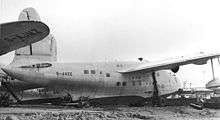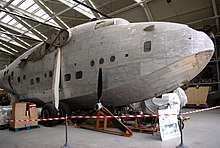Short Sandringham
The Short S.25 Sandringham was a British civilian flying boat produced during the Second World War by the demilitarized conversions of Short Sunderland military flying boats previously operated by the Royal Air Force.
| Short Sandringham | |
|---|---|
 | |
| Ansett Sandringham taking off from Lord Howe Island in the early 1960s | |
| Role | Civil flying boat |
| Manufacturer | Short Brothers |
| First flight | January 1943 |
| Introduction | 1943 |
| Retired | 1974 (Ansett Flying Boat Services) |
| Primary users | BOAC Qantas TEAL Ansett Flying Boat Services |
| Developed from | Short Sunderland |

Design and development
From late 1942, six RAF Sunderland IIIs were stripped of their armament and fitted with bench-type seats, gaining civil markings and registrations and joining the airline BOAC. Six more Sunderlands were converted for transport use in 1943, with a further 12 following in 1944.[1][2] Following the end of the Second World War, BOAC converted its Sunderlands to a less-austere standard, more suitable for peace-time operations as the "Hythe"-class. The primitive bench seats were removed, with seats fitted for sixteen passengers on one deck in the initial H.1 configuration, with the addition of a promenade deck giving the H.2 configuration, while the H.3 layout had an additional eight seats. 6,500 pounds (2,900 kg) of mail could be carried. Engines were standardised as the Bristol Pegasus 38.[3][4]
In November 1945, Shorts flew a further refined conversion of one of BOAC's Sunderlands from their Rochester works, with revised low-drag fairings on the aircraft's nose and tail, and a refurbished interior, which was known as the Sandringham. All the Sandringhams were civil conversions of former Royal Air Force Coastal Command Short Sunderlands. The first prototype retained the Pegasus engines of the Sunderland III and Hythe, and was designated the Sandringham 1 by Shorts, but later Sandringhams, converted by Short and Harland Ltd at Belfast Harbour, were based on the Sunderland V, and were powered by Pratt & Whitney "Twin Wasp" engines.[5]
In 1963 an additional conversion of a former Royal New Zealand Air Force Sunderland V was carried out by Ansett to a similar standard to the Sandringhams. The aircraft, named Islander, was fitted with a 43-seat interior.[6]
Operational use


The converted Sunderlands commenced operations with BOAC on the Poole Harbour, Dorset and Lagos, Nigeria in March 1943.[3][7] Following a proving flight to British India, the Sunderlands were transferred in October 1943 to flights between Poole and Karachi, via Gibraltar and Cairo. As Egypt was under military control, the aircraft were given military serial numbers and operated as part of RAF Transport Command.[1][8] The service was extended to Calcutta in May 1944, while VE-Day, the end of the war in Europe, allowed the aircraft reverted to BOAC control. They continued on the India route, which was extended again to Rangoon in Burma following VJ-Day.[9]
BOAC's Hythes took on flights to Australia in 1946, starting flying the Poole–Sydney route in conjunction with Qantas on 12 May 1946. In August that year, BOAC's Hythes were also deployed on services to Hong Kong on what was known as the Dragon route.[4][10]
The Sandringham 5 was operated by BOAC from 1947 as the "Plymouth class" on the Far East routes from Southampton via Alexandria to Hong Kong and Tokyo. These were replaced by Lockheed Constellation land planes during 1949. TEAL used Sandringhams on the Auckland to Sydney route and flights to Pacific Islands. In 1950, Qantas introduced the first of five aircraft which flew from the Rose Bay flying boat base on Sydney Harbour to destinations in New Caledonia, New Hebrides, Fiji, New Guinea and Lord Howe Island. Two of these were purchased from TEAL and the other three were purchased from BOAC. These were in service through to 1955.[11]
The type was used by Ansett Flying Boat Services on the Sydney (Rose Bay) to Lord Howe Island scheduled service until 1974. One of Ansett's Sandringhams was converted from a S-25 Sunderland previously owned by the Royal New Zealand Air Force. It was also used in Norway by DNL – Norwegian Airlines 1946–1952 on the domestic service from Oslo to Tromsø, and in Uruguay by Compañía Aeronáutica Uruguaya S.A. (CAUSA) on the passenger services between Montevideo and Buenos Aires (1950–1962).
In October 1954, Captain Sir Gordon Taylor flew his newly acquired Sandringham 7 from the UK to Australia to begin a series of flying boat cruises of the south Pacific. The aircraft later passed to Réseau Aérien Interinsulaire in Tahiti and is now stored at the Musée de l'Air et de l'Espace at Paris Le Bourget.
One of the last operators of the Sandringham was Antilles Air Boats in the Virgin Islands of the Caribbean which flew the aircraft in scheduled passenger service during the 1970s with flights from the Charlotte Amalie Harbor Seaplane Base on St. Thomas and the Christiansted Harbor Seaplane Base on St. Croix among other destinations.[12]
Variants
- Hythe
- Modification of Sunderland III for BOAC, with seats for 16–24 passengers.[4] 23 converted.[13]
- Sandringham 1
- Full civil conversion of Sunderland 3 for BOAC, accommodating 24 day or 16 sleeper passengers, and powered by four 1,030 hp (768 kW) Bristol Pegasus 38 engines. One converted.[5]
- Sandringham 2
- Civil conversion of Sunderland 5 for Argentine airline Dodero, accommodating 45 day passengers. Powered by four R-1830-92 engines, three conversions.[14]
- Sandringham 3
- Conversion of Sunderland 5 with dining room and galley on upper deck and seats for 21 on lower deck. Two converted.[14]
- Sandringham 4
- Four converted for TEAL of New Zealand (Tasman class). Seating for 30 passengers.[14] Two were sold to Qantas and operated by them between 1950 and 1955, with the remaining two sold to Ansett.[11]
- Sandringham 5
- Nine converted for BOAC (Plymouth class), accommodating 22 day or 16 sleeper passengers.[15] Three of these were sold to Qantas which operated them between 1951 and 1955.[14]
- Sandringham 6
- Radar equipped aircraft for Norwegian airline DNL. 37 passengers. Five converted.[14]
- Sandringham 7
- Thirty seat aircraft for BOAC (Bermuda class). Three converted.[16]
- Islander
- An additional civil conversion by Ansett officially described as a Sunderland Mark V (Modified).
Operators
- Aerolíneas Argentinas
- Sociedad Mixta Aviación del Litoral Fluvial Argentino (ALFA)
- Cooperativa Asociación Argentina de Aeronavegantes
- Compañía Argentina de Aeronavegación Dodero
- Reseau Aerien Interinsulaire (RAI) and successor Air Polynesie (now Air Tahiti) in French Polynesia
- Det Norske Luftfartselskap
- Compañía Aeronáutica Uruguaya S.A. (CAUSA)
- Antilles Air Boats
Survivors

- Ex-Ansett Sandringham (RAF Serial ML814 Short Sunderland MR5) c/n SH.974b. To RNZAF No.5 Squadron 1953 Fiji and became NZ4108. Hobsonville, New Zealand 1956–1963. Sold 1963 to Airlines of New South Wales. Converted to passenger configuration and registered VH-BRF and named Islander. To Antilles Air Boats, Virgin Island as N158J in 1974. To Edward Hulton in the UK in 1979 as G-BJHS Spirit of Foynes. Storm damaged and repaired. Sold to Kermit Weeks in 1992 and re-registered N158J. On display at the Fantasy of Flight museum in Polk City, Florida, USA with Kermit Weeks and registered as N814ML on 16 September 1993.
_(6811351068).jpg)
- Ex-Ansett Sandringham (RAF Serial JM715 Short Sunderland Mk III) flew for Tasman Empire Airways Ltd. (TEAL) of New Zealand purchased JM715 from the Air Ministry for conversion. After conversion at Short's Belfast factory, the aircraft was allocated the conversion number SH.55C and registered to TEAL, delivered from Southampton to Waitemata Harbour, Auckland on 29 October 1947 and was soon in service on the 1,300-mile Sydney–Auckland route. In May 1950, ZK-AMH, was sold to Barrier Reef Airlines of Australia where it was renamed Beachcomber and registered VH-BRC. Barrier Reef Airlines were subsequently taken over by the major Australian airline Ansett and became Ansett Flying Boat Services and operated out of Rose Bay, Sydney, Australia until 1974. The vast amounts of money required to keep the aircraft in flying condition were not available and in 1981, the aircraft was purchased for the National Aeronautical Collection by the Science Museum and is now on display at Solent Sky museum in Southampton, Hampshire, UK.

- Short S-25 Sandringham 7 Bermuda Class. c/n SH-57C. Built as a (RAF Serial JM719 Short Sunderland Mk III). Converted to Short S-25 Sandringham 7 Bermuda Class 1947 for BOAC British Register as G-AKCO St. George. Sold to Sir Patrick Gordon Taylor 1954. Registered VH-APG Frigate Bird III. Sold to Reseau Aerian Interinsulaire 1958. Registered F-OBIP. Final Flight 1970 Papeete, Tahiti. Initially donated to Queensland Air Museum 1975. Relocation proved cost prohibitive. Acquired by Musée de l'Air et de l'Espace at Le Bourget Airport, 1977. Transported by French military to Paris in 1979 and placed on display, but was severely damaged during a storm on 8 February 1984.[17] Under restoration since 2008, and as of January 2018 not currently viewable by the public.
Specifications (Sandringham 5)

Data from British Civil Aircraft 1919–1972 [18]
General characteristics
- Crew: 5
- Capacity: 22 day passengers or 16 sleeper passengers
- Length: 86 ft 3 in (26.29 m)
- Wingspan: 112 ft 9.5 in (34.379 m)
- Height: 22 ft 10.5 in (6.972 m)
- Wing area: 1,687 sq ft (156.7 m2)
- Airfoil: Göttingen 436 modified [19]-->
- Empty weight: 39,498 lb (17,916 kg)
- Gross weight: 60,000 lb (27,216 kg)
- Fuel capacity: 2,032 imp gal (2,440 US gal; 9,238 l)[20]
- Powerplant: 4 × Pratt & Whitney R-1830-92D Twin Wasp / -90B 14-cylinder air-cooled radial piston engines, 1,200 hp (890 kW) each
- Propellers: 4-bladed Hamilton Standard Hydromatic, 12 ft 1 in (3.68 m) diameter constant-speed propellers
Performance
- Maximum speed: 206 mph (332 km/h, 179 kn)
- Cruise speed: 176 mph (283 km/h, 153 kn)
- Range: 2,440 mi (3,930 km, 2,120 nmi)
- Service ceiling: 17,900 ft (5,500 m)
- Rate of climb: 840 ft/min (4.3 m/s)
- Wing loading: 35.6 lb/sq ft (174 kg/m2)
- Power/mass: 0.08 hp/lb (0.13 kW/kg)
See also
Aircraft of comparable role, configuration and era
Related lists
References
- Citations
- Barnes 1967, pp. 398–399.
- London 2003, pp. 203–204.
- Jackson 1988, p. 152.
- London 2003, p. 215.
- Jackson 1988, pp. 152–153.
- London 2003, p. 226.
- Barnes 1967, p. 398.
- London 2003, p. 204.
- Barnes 1967, p. 399.
- Barnes 1967, p. 400.
- Barnes 1967, p. 405.
- http://www.airliners.net, photos of Antilles Air Boats Short Sandringham in the U.S. Virgin Islands
- London 2003, pp. 278–279, 281.
- Jackson 1988, p. 153.
- Jackson 1988, p.154.
- Jackson 1988, p.155.
- "Short S.25 Sandringham Mk7 Bermuda F-OBIP". Musée de l’Air et de l’Espace (in French). Retrieved 9 January 2018.
- Jackson 1988, p. 156.
- Lednicer, David. "The Incomplete Guide to Airfoil Usage". m-selig.ae.illinois.edu. Retrieved 16 April 2019.
- Bridgman, Leonard, ed. (1947). Jane's All the World's Aircraft 1947 (35th ed.). London: Sampson Low, Marston & Co. pp. 74c–75c.
- Bibliography
- Barnes, C. H. Shorts Aircraft since 1900. London: Putnam, 1967
- Jackson, A. J. British Civil Aircraft since 1919 – Volume Three. London: Putnam & Company Ltd, 1974. ISBN 0-370-10014-X.
- Jackson, A. J. British Civil Aircraft 1919–1972: Volume Three. London: Putnam, 1988. ISBN 0-85177-818-6.
- London, Peter. British Flying Boats. Stroud, UK: Sutton Publishing, 2003. ISBN 0-7509-2695-3.
- "Short Sandringham: Sunderland's Civil Version: Improved Form and Interior." Flight, 19 July 1945, Volume XLVIII, Number 1908. pp. 63–65.
External links
| Wikimedia Commons has media related to Short Sandringham. |
- video of a Short Sandringham (misidentified as a Sunderland) landing on water from the old movie titled "el delito"